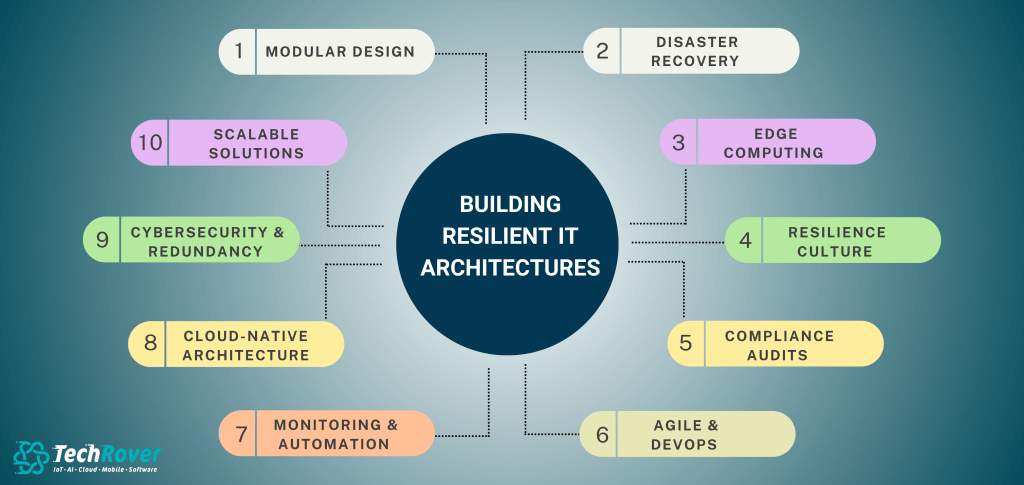Building Resilient IT Architectures: Strategies for Modern Businesses

In today’s fast-paced digital landscape, building resilient IT architectures is not just a priority; it’s a necessity for modern businesses. Resilience in IT infrastructure goes beyond merely withstanding disruptions; it encompasses adapting to continuous changes and evolving business requirements. This article explores critical strategies to achieve such resilience and why they are essential for businesses striving to stay ahead.
1. Embracing Modular Design
The modular design principle involves constructing IT systems with interchangeable parts or modules, facilitating easier updates or replacements without overhauling the entire system. This approach ensures high adaptability and reduced downtime. Google exemplifies this strategy with its server design, utilizing modular components to seamlessly upgrade or replace parts, thereby maintaining high performance and reliability.
2. Investing in Scalable Solutions
Scalability is crucial for IT architecture to manage increased loads without performance degradation. Amazon Web Services (AWS) is a prime example of scalable design. During peak shopping periods like Black Friday and Cyber Monday, AWS dynamically scales to handle the surge in traffic, ensuring uninterrupted service and optimal performance. Such scalable solutions are essential for businesses to manage growth and unexpected spikes in demand effectively.
3. Prioritizing Cybersecurity and Data Redundancy
In an era of escalating cyber threats, robust cybersecurity measures are non-negotiable. Microsoft Azure employs multi-layered security across physical data centers, infrastructure, and operations to protect against cyber threats. Additionally, data redundancy is critical for disaster recovery. The 2011 earthquake and tsunami in Japan underscored the need for offsite data backups, as businesses with robust data redundancy plans could recover more quickly from the disaster.
4. Implementing Cloud-Native Architectures
Cloud-native architectures, designed to leverage the scalability and flexibility of cloud computing, are becoming increasingly essential. Netflix’s transition to a cloud-native architecture is a testament to this approach, enabling the company to manage massive content delivery efficiently while adapting to fluctuating demands. Cloud-native solutions provide the agility and scalability necessary for modern businesses to thrive.
5. Fostering Continuous Monitoring and Automation
Continuous monitoring and automation significantly enhance IT infrastructure resilience. IBM’s AI-powered monitoring tools, for instance, can predict and prevent system anomalies before they cause disruptions. Automated processes minimize human error, a common cause of IT outages, and ensure smoother, more reliable operations. Continuous monitoring allows businesses to proactively address potential issues, maintaining high availability and performance.
6. Adopting Agile and DevOps Practices
Agile and DevOps practices promote flexibility and rapid response to change, essential for resilient IT architectures. Spotify’s squad model, a variant of Agile methodology, allows small, cross-functional teams to innovate and adapt swiftly to changing user preferences and market conditions. By fostering collaboration and continuous improvement, Agile and DevOps practices enable organizations to respond quickly to new challenges and opportunities.
7. Ensuring Compliance and Regular Audits
Regular compliance checks and audits ensure IT architectures meet industry standards and best practices. The EU’s General Data Protection Regulation (GDPR) has prompted organizations to reevaluate their data handling and privacy protocols, leading to more resilient and compliant IT systems. Compliance with regulations not only protects businesses from legal repercussions but also enhances their credibility and trustworthiness.
8. Integrating Edge Computing
Edge computing, which processes data closer to where it is generated, reduces latency and improves performance. This is particularly useful for applications that require real-time processing and quick decision-making. By integrating edge computing, businesses can enhance their IT infrastructure’s responsiveness and reliability.
9. Developing Robust Disaster Recovery Plans
A comprehensive disaster recovery plan is crucial for IT resilience. This includes regular backups, offsite storage, and clear protocols for data recovery in case of a disaster. Businesses should regularly test their disaster recovery plans to ensure they can quickly restore operations and minimize downtime.
In conclusion, building resilient IT architectures requires a multifaceted approach that incorporates modular design, scalable solutions, robust security, cloud-native architectures, continuous monitoring, Agile and DevOps practices, compliance checks, and a resilient culture. By embracing these strategies, businesses can enhance their IT infrastructure’s resilience, ensuring they can adapt to changes, withstand disruptions, and continue to thrive in an ever-evolving digital landscape.


